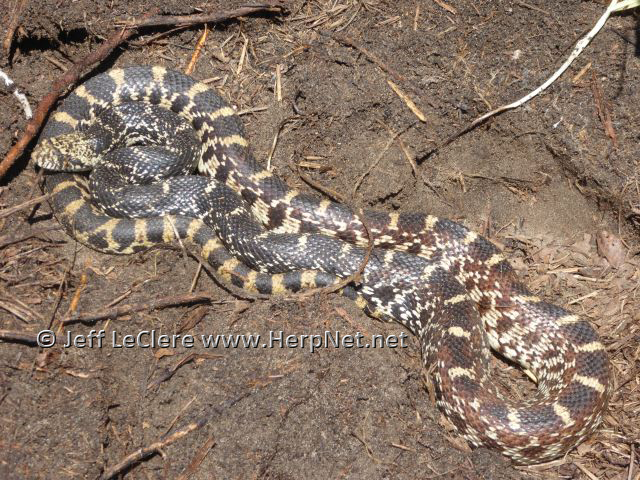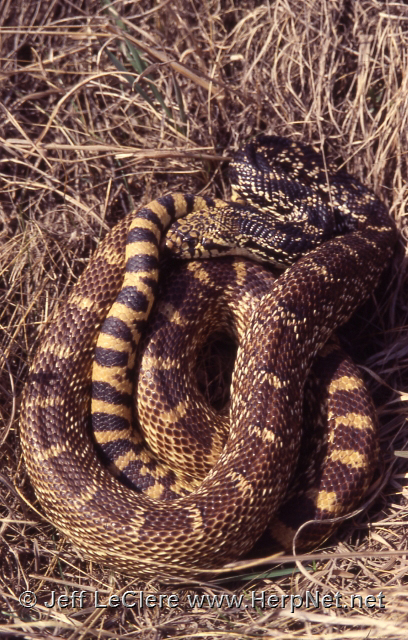Gopher Snake (Pituophis catenifer)
Alternate names: Gophersnake
by Jeff LeClere
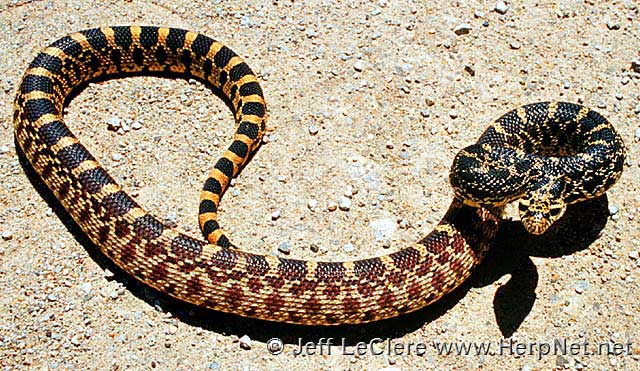
Status
SPECIAL CONCERN and Species of Greatest Conservation Need. It is illegal to kill or collect this species by law in Iowa.
Description
The gopher snake is the largest species of snake in Iowa. This snake ranges from 37 – 72 inches (94.8-183 cm) in length. Max 100 inches (254 cm) (Conant and Collins 1991). This snake looks like there are three snakes in one. The ground color varies from white in the neck region, dull yellow-brown on the mid body, and bright yellow on the tail. Sometimes the entire body and head is straw yellow.

There are over 40 large, dark, body blotches that are usually black in the neck region, lighter brown or reddish brown on the mid body, then become dark black bands or rings on the tail. There are also smaller spots on the sides that sometimes connect, and even form a network. The side scales are also tipped with brown or black that produce a speckled appearance on the sides.
The head is usually yellow or brown and is boldly marked with black, including a stripe across the top of the head from eye to eye, barring on the labial scales, and a stripe from the eye to the corner of the mouth. The head markings are usually unique enough to identify individuals. The throat and underside of the neck are porcelain white becoming yellowish with brown squares or spots on the belly. This snake has an enlarged rostral (snout) scale, typically four prefrontal scales, keeled scales, and a single anal plate. Hatchlings are patterned like adults but are gray until after they shed for the first time.
Gopher snakes may be just over a foot at hatching (8 – 13 inches; 20.3 – 33 cm). A few hybrids between bullsnakes and western fox snakes have been found in Madison and Linn counties Iowa, Wabasha County Minnesota, and an unverified report from Illinois (LeClere et al. 2012; Pinto et al. 2018).
Subspecies
The subspecies of gopher snake found in Iowa is the bullsnake, Pituophis catenifer sayi. The subspecies name honors Thomas Say, an 1800’s naturalist.
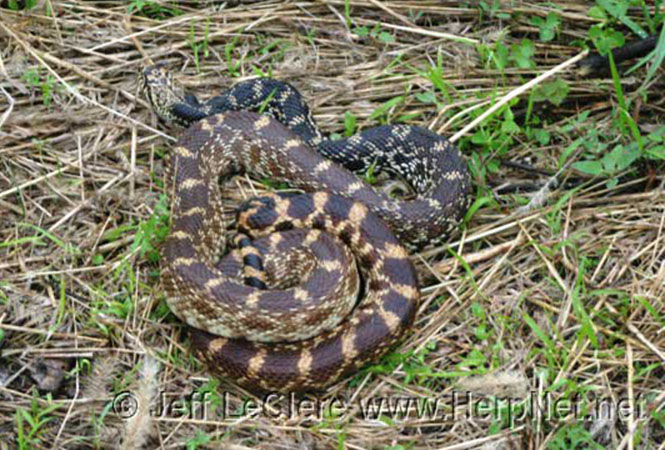
Similar Species
Western fox snakes have a divided anal plate, weakly keeled scales, rounded snout, two prefrontal scales, and lack speckling on the sides. Prairie kingsnakes have smooth scales, lack speckling on the sides, and usually have two longitudinal blotches on the neck. Common water snakes have a divided anal plate and are banded on the anterior third of the body.
Range
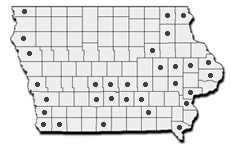
The bullsnake is found statewide in Iowa.
Habitat and Habits
Bullsnakes are active April to October. This species favors native sand prairie, tallgrass prairie, bluff prairie, oak savanna, and pasture. Most surface activity occurs in spring and fall; during the warmer months they are rather fossorial and may become nocturnal. Usually, sandy soils that allow for easy burrowing are preferred. The pointed head and tough rostral scale help them burrow through loose sand or penetrate mammal burrows.
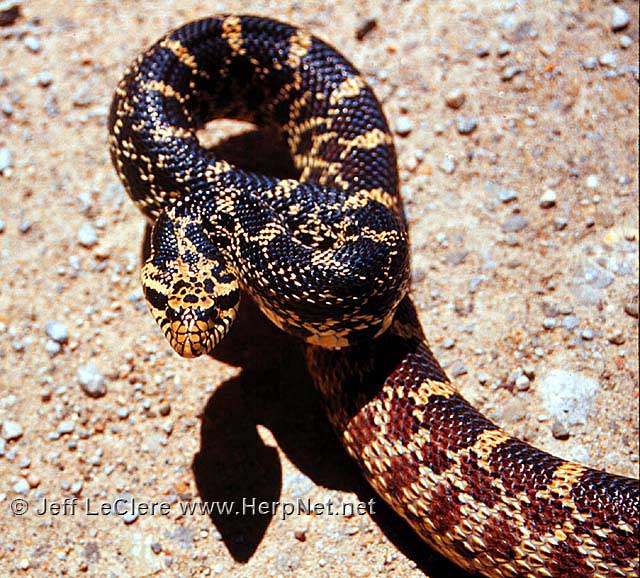
Bullsnakes apparently have large home ranges. A three year radio telemetry study conducted in southwestern Wisconsin showed that site fidelity was strong and that males had larger home ranges (41 ha) than females (23 ha). The preferred habitat was bluff or hill prairie, and habitat preference did not shift seasonally. Agricultural land was typically avoided and nearly all of the individuals that used agricultural land were killed by farm machinery or road killed (Kapfer et al. 2008b). An ongoing radio telemetry study in both southeastern and western Minnesota by LeClere et al. also showed high site fidelity and a marked avoidance to agricultural land. The favored habitat was either sand prairie or mixed prairie bluffs, now converted to pasture. Some individuals spent over a month consecutively in a deep expansive cattail marsh. Some snakes moved over a mile if suitable habitat allowed. In sand prairie habitat, individuals nested and overwintered individually. Burrows were the most commonly used refuge, and some mortality would occur during periods of exceptionally deep frost in winter. In pasture habitat, communal nesting and overwintering was observed. Rotting trees, both downed and standing, were commonly used for refuge. In both habitats, bullsnakes appeared to avoid restorations consisting of tall and densely planted grasses, and fox snakes were uncommon or absent onsite, though they could commonly be found in the surrounding area (LeClere et al. unpublished data).
The bullsnake was once considered Iowa’s most common constricting snake species. Guthrie (1926) stated that this species was better known than any other snake species except for the garter snakes. Loomis (1948) remarked that “the bullsnake is the most common snake in Adams County.” The bullsnake is now in severe decline, and the vast majority of the state’s population is gone. Compared against Bailey’s collections from 1939 to 1942, Christiansen (1998) reports a 91.3 percent loss of Iowa’s bullsnake population. This snake requires large tracts of open prairie, once the dominant habitat, now very rare in Iowa (LeClere 1998). Increased traffic on roadways that now fragment habitat into smaller tracts have also contributed to the decline in numbers. Conservation efforts should include proper restoration of large continuous tracts of open prairie, ideally connected to existing bullsnake populations. Open sand prairie or bluff prairie habitat with bullsnake populations must be preserved in Iowa. This species overwinters in mammal burrows and other underground retreats. Populations found on bluff prairies overwinter in rocky crevices with timber rattlesnakes, western rat snakes, eastern milk snakes and racers.
Bullsnakes rely upon coloration and pattern camouflage to avoid detection. When cornered, they may coil, spread their jaws, hiss, and vibrate their tails which produces a buzzing sound against dried vegetation. The hiss produced by this snake is the longest and loudest of any Iowa snake. A flap of cartilage in front of the trachea vibrates as air is forced past it which gives the hiss its raspy quality. When handled, bullsnakes may strike or struggle; most become calm.
Reproduction
Bullsnakes mate in April or May. Courtship was observed on 26 May in Adams County, but actual copulation was not seen (Loomis 1948). The male crawls alongside and over the female, making rhythmic motions with his body. A few males may attempt to court one female, and sometimes males may combat one another. Just before copulation, the male may grasp the female’s head or neck in his mouth. Copulation can become quite violent, both snakes wrapping about each other and may last from several minutes to hours.
In southwestern Wisconsin, females became gravid every year. Mortality rates were highest in gravid females basking in the open to maintain higher body temperatures during egg development, leaving them more vulnerable to coyotes and humans (Kapfer et al. 2008a). In Minnesota, copulation has been observed in May, and males may either combat with one another or attempt to court the same female. I observed two males attempting to court the same female in Hennepin County, Minnesota. In Linn County, Iowa, the highest number of noticeably gravid females is found in early June.
Bullsnakes are oviparous and lay from 8 to 24 eggs in burrows, under logs or rocks, or other humid protected areas in late June or early July. A radio-tracked bullsnake laid 9 eggs 263 mm underground in a branch of a pocket gopher burrow (Iverson et al. 2007). A female I collected from Linn County laid 13 eggs. Best (1977) dissected a 133 cm female from Story County on 17 June and found 14 developing eggs. The majority of the eggs in a single clutch adhere to one another after they are laid. The eggs hatch in August or September.
Food
Bullsnakes are powerful constrictors. Prey are mostly small mammals and include pocket gophers, meadow mice, voles, shrews, ground squirrels, rabbits, squirrels, birds and bird’s eggs, frogs, and lizards. Guthrie (1926) found three striped ground squirrels in one individual’s stomach and full-grown pocket gophers and half-grown rabbits in other specimens. Best (1977) found a bullsnake raiding a rough-winged swallow nest 53 cm high in a stream bank in Story County eating four eggs.
Radioed snakes in Minnesota have been observed feeding several times. Prey consisted of cottontail rabbits, turkey eggs, mice and voles. Raiding of small mammal nests was common (LeClere et al. unpublished data). Bullsnakes kill larger prey by constriction but simply swallow smaller prey alive. Rodents met underground may be killed by pressing them against the wall of the burrow with the body. They are extremely valuable to farmers as excellent controllers of rodent pests.
